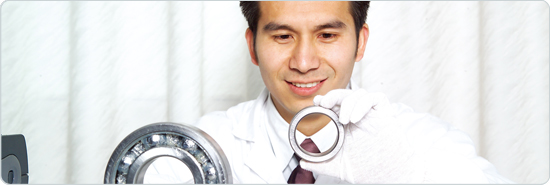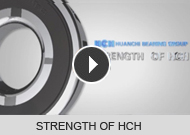- Main Clients and markets
- Customer Service
- Bearing Selection services
- Bearing Handling Service
- Bearing Fitting Service
- Lubrication Service
- Preload
-
Bearing cleanliness

Proper mounting allows the load to be transmitted to the ring experiencing the interference fit. Mounting forces are not transmitted via the rolling elements, helping to prevent damage to the raceways. To fix a radial bearing to a shaft, generally bring the bearing into close contact with the shaft shoulders and spacer and fix it in position by tightening the shaft nut. The ends of the shaft shoulders and the spacer must be perpendicular, bearing rotation accuracy and roller contact performance will be adversely affected, resulting in heat generation and premature fatigue. The same care must be taken to ensure the proper contact between the housing shoulders and the lateral face of the outer rings.

● Prevent 16% of premature bearing failures
Around 16% of all premature bearing failures are a result of poor fitting or using incorrect mounting techniques. Individual applications may require mechanical, heat or hydraulic mounting methods for correct and efficient bearing mounting. Selecting the mounting technique appropriate for your application will help you extend your bearing’s service life and reduce costs resulting from premature bearing failure as well as potential damage to the application.
● Warning in installation

● Fitting consideration
Bearing fits are selected by reviewing the application details, general guidelines and with experience. The fit, or amount of interference that exists between mating components, can be devised into three resultant categories: press fit, transition fit and loose fit. Typically, an inner ring rotating application will use a tight or interference fit on the shaft, and the housing will use a loose or clearance fit. Likewise, with an outer ring rotating application, the opposite is true. To determine the shaft and housing fits required for a particular application, one must consider such variables as load, ambient temperature and the type of bearing. Moreover, the following questions should be answered:
What is the bearing size and type?
Is the application inner or outer ring rotating?
What is the load direction and condition?
What kind of shaft and housing are being used? i.e. -Is the shaft solid or hollow?
-Are the shaft and housing of steel or aluminum construction?
For the details, please check the next section: bearing fitting service.
● Personal Safety- From You to Everyone Around
To keep you and those around you safe always read the Instruction manuals before operating any of our products and pay particular attention to the safety warnings.
1. Always wear protective clothing and goggles when mounting and dismounting rolling element bearings.
2. Always use heat resistant gloves when mounting heated bearings and when dismounting bearings using heat.
3. For your own safety, please do not strike the bearing directly with any hard object such as a hammer or chisel.
4. Select a suitable puller for the application with sufficient pulling force in order to help prevent puller overload. Overloading a puller can result in puller arm or beam breakage, causing personal injury.
5. A safety blanket fitted around the puller and bearing helps reduce the risk on injury in case the puller's arm breaks.
6. Remember that corrosion on the interference fit may require significantly higher dismounting force. If the interference fit is corroded, use penetrating oil to dissolve/loosen the rust.
7. Powerful forces may be involved when dismounting bearings and care must always be taken to avoid injury.




